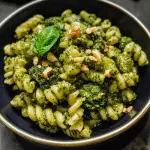Description
If you’re looking for a fresh, nutrient-packed twist on the classic pesto, Broccoli Walnut Pesto is a vibrant and healthy option that’s just as flavorful as it is versatile. This pesto combines tender, blanched broccoli with the richness of toasted walnuts and the aromatic flavor of garlic, all blended into a smooth, vibrant green sauce. It’s a great way to incorporate more vegetables into your diet without compromising on taste. The walnuts provide a delightful nuttiness and healthy fats, while the broccoli adds a hefty dose of fiber, vitamin C, and antioxidants. This pesto can be tossed with pasta, drizzled over roasted vegetables, spread on toast, or used as a dip for your favorite snacks. Quick to prepare and packed with nutrients, it’s a great option for a wholesome, satisfying meal or snack. Whether you’re looking to boost the nutritional value of your meals or just want to try something new, this Broccoli Walnut Pesto is sure to be a hit in your kitchen.
Ingredients
- 2 cups broccoli florets: Fresh broccoli is the base of this pesto. It provides a mild, slightly bitter flavor that complements the other ingredients. You can use frozen broccoli if fresh isn’t available, though fresh broccoli will give you the best flavor and texture.
- 1/2 cup walnuts: Walnuts are a great choice for this pesto due to their rich, nutty flavor. They also contribute healthy fats and protein. If you don’t have walnuts, you can substitute them with other nuts like almonds, pine nuts, or even sunflower seeds.
- 2 cloves garlic: Garlic adds a savory depth to the pesto and is essential in giving the sauce its characteristic bold flavor. You can adjust the amount of garlic depending on how much you enjoy its taste.
- 1/4 cup extra virgin olive oil: Olive oil is the key ingredient that helps blend the pesto into a smooth, creamy consistency. The high-quality fat adds richness and enhances the flavor of the other ingredients.
- 1/4 cup grated Parmesan cheese: Parmesan is a classic ingredient in pesto, giving it a salty, umami flavor. If you are following a dairy-free or vegan diet, you can replace the Parmesan with nutritional yeast or another plant-based cheese substitute.
- Juice of 1 lemon: Lemon juice brings a bright acidity that balances out the richness of the olive oil and walnuts. It cuts through the earthiness of the broccoli and brightens the overall flavor of the pesto.
- Salt and freshly ground black pepper: Salt and pepper are crucial for enhancing the flavors of the pesto. Be sure to season to taste, as the right amount of salt can really elevate the overall dish.
- Water: You’ll need a small amount of water to adjust the consistency of the pesto. Add it gradually to achieve your desired thickness.
Instructions
Step 1: Blanch the Broccoli
Start by blanching the broccoli florets. This is a key step that ensures the broccoli retains its vibrant color, tender texture, and nutritional benefits. To blanch the broccoli, bring a large pot of salted water to a boil. Add the broccoli florets and cook them for about 2-3 minutes. The broccoli should turn bright green and be slightly tender but still have some crunch.
Once the broccoli is blanched, use a slotted spoon to transfer it to a bowl of ice water to stop the cooking process. This technique, known as shocking, helps the broccoli maintain its bright color and prevents it from becoming mushy. Let the broccoli cool in the ice water for a few minutes, then drain it well and pat it dry with a paper towel to remove any excess water. This will ensure that your pesto doesn’t become too watery.
Step 2: Toast the Walnuts (Optional)
While the broccoli is cooling, you can toast the walnuts for a deeper flavor. To toast the walnuts, heat a small skillet over medium heat. Add the walnuts to the pan and cook, stirring occasionally, for about 2-3 minutes, or until they become fragrant and lightly golden. This step intensifies the nutty flavor of the walnuts and adds a subtle smokiness to the pesto.
If you’re short on time or prefer a more subtle walnut flavor, you can skip this step. The pesto will still be delicious without toasting the walnuts, but the toasted version adds an extra layer of complexity.
Step 3: Blend the Ingredients
Once the broccoli and walnuts are ready, transfer them to a food processor. Add the garlic, Parmesan (or nutritional yeast), lemon juice, olive oil, salt, and pepper to the food processor as well. Pulse several times to break down the ingredients, then continue blending until the mixture becomes smooth and creamy. You may need to stop and scrape down the sides of the processor to ensure everything is fully incorporated.
If the pesto is too thick for your liking, you can thin it out by adding a little bit of water or more olive oil, one tablespoon at a time, until it reaches your desired consistency. Taste the pesto and adjust the seasoning as needed. Add more salt, pepper, or lemon juice to balance the flavors if necessary.
Step 4: Serve
Once your pesto is ready, you can serve it in a variety of ways. The most common use is to toss it with pasta. If you’re using pasta, make sure to reserve some pasta water to thin the pesto and help it adhere to the noodles. Broccoli Walnut Pesto also works well as a topping for roasted vegetables, such as sweet potatoes, cauliflower, or Brussels sprouts. Spread it on toast, drizzle it over grilled meats, or serve it as a dip with fresh veggies or crackers. The possibilities are endless!
- Prep Time: 10 minutes
Nutrition
- Calories: 180 kcal
- Fat: 15g
- Carbohydrates: 8g
- Protein: 5g
